The multi-billion dollar GMO herbicide Glyphosate is carcinogenic. Sold as Roundup by Bayer (formerly Monsanto), it is one of the most toxic substances ever launched on the public, responsible for cancers and other diseases, and has significant negative effects on ecosystems across the world. California has agreed to add glyphosate, the main ingredient of Monsanto’s Roundup, to the list of known carcinogens.
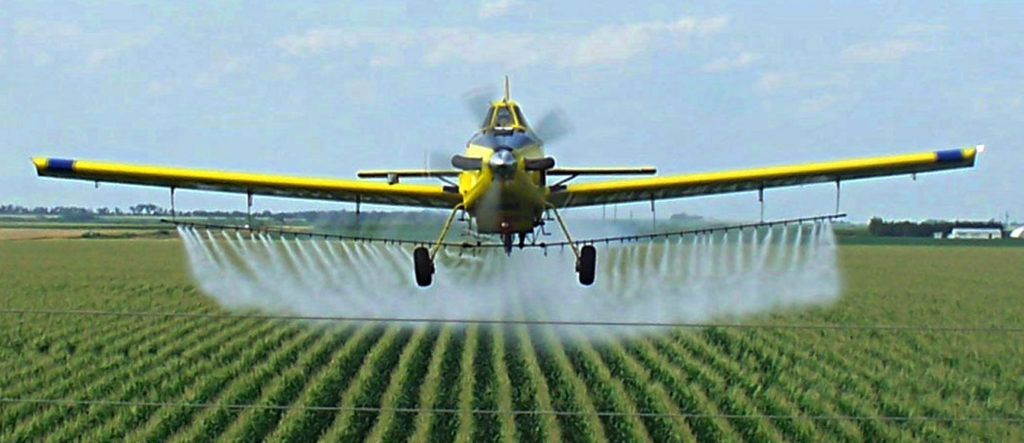

Glyphosate is Carcinogenic…Misery in a Bottle!
By Stephen C. Frantz, Published in LA Progressive
Glyphosate is the primary active ingredient in the ever popular Roundup® herbicide, a chemical used on food and non-food crops, as well as non-crop areas such as lawns, gardens, playgrounds, rights-of-way, etc. It kills nearly any plant life it contacts above ground and under water. Glyphosate (GLY) is widely sold by garden shops, hardware stores, and agricultural suppliers; it is the most widely used herbicide the world. And its residues are found everywhere: in your food, in your water, in your air, and in you, your children, pets and other animals.
There has been a long debate on the toxicity and health relevance of GLY, but that is now over. Fortunately, Dr. Anthony Samsel (Union of Concerned Scientists) and Dr. Stephanie Seneff (MIT) have recently procured a hoard of scientific documents covering decades of Bayer-owned Monsanto’s sealed GLY research (Gale & Null 2015). We’ve been misled by industry, university, and government scientists and officials who told us that GLY did not present an unreasonable risk of adverse effects to humans, animals, or the environment. In fact, Samsel and Seneff conclude that GLY is undoubtedly one of the most toxic substances ever launched on the public, and which adversely affects almost every tissue and cell in a mammal’s body. This is also backed-up by years of peer-reviewed research by others (Anon 2014), some of which is included herein.
GLY and its formulations are responsible for a large variety of cancers and organ failures in humans and other animals. It harms or kills honey bees (Balbuena, et al. 2015; Morandi, et al. 2005), monarch butterflies (Landrigan & Benbrook 2015; Pleasants & Oberhausser 2012), amphibians (Annett, et al. 2014; Quarles 2015a; Székács & Darvas 2011), fish, crustaceans, eels, caiman, snails, mice, rats, rabbits, dogs, pigs (Carman, et al. 2013), poultry and cattle (Samsel & Seneff 2013), various microorganisms, and other life (Gale & Null 2015; Quarles 2014; Quarles 2015b; Seralini et al. 2014; Székács & Darvas 2011). Indirectly, GLY applications have also reduced populations of beneficial insects, birds and small mammals by destroying the vegetation on which they depend for food and shelter (Cox 2000). The magnitude of these toxic revelations equals or exceeds the decades-long “Big Tobacco” cover-up. The question is, how will regulatory agencies manage GLY production and usage that insidiously harm humans, animals, and the environment everywhere?
Multi-Billion Dollar Product, Glyphosate, Darling of GMO Agribusiness
GLY formulations are made for lawns, gardens, agriculture, forestry, industrial areas, and to kill aquatic plants. It was the “first billion dollar product” of the pesticide industry (Franz et al. 1997), and more than 280 million pounds of GLY are used every year (Kustin 2015) on more than a billion acres of U.S. crops (Cherry 2010).
The estimated global production of GLY in 2012 was 1.6 billion pounds (Transparency Market Research 2014). About 45% of the total usage was for genetically modified, GLY-tolerant crops (GMOs*), a significant concomitant problem. The global GLY market is expected to be $8.79 billion by 2019 (Transparency Market Research 2014). It’s easy to understand why agribusiness is opposed to having GLY products sensibly regulated which, at present, they are not.
* GMO = a genetically modified organism (or transgenic organism) is any organism whose genetic material has been altered using genetic engineering (aka “genetic tinkering”) techniques.
In California in 2013, more than 10 million pounds of glyphosate products were applied on agricultural crops alone (CA-DPR 2015). Non-crop usage was not reported; however, in a 2013 survey of 246 Northern California households, 14% were found to possess at least one glyphosate-containing product (Guha, et al. 2013). The CA-DPR data also show that almost 194 million pounds of pesticide (all) active ingredients (excluding adjuvants, carriers, etc.) were used throughout CA croplands in 2013 (CA-DPR 2015). Los Angeles County ranked 20th with a mere 2½ million pounds of pesticides applied.
Not only are the sheer volumes of reported pesticide application remarkable, but we also know little regarding the toxic cocktails’ ingredients and the pesticide interactions to which we are unwittingly exposed every day. If this is not alarming enough, please read on…
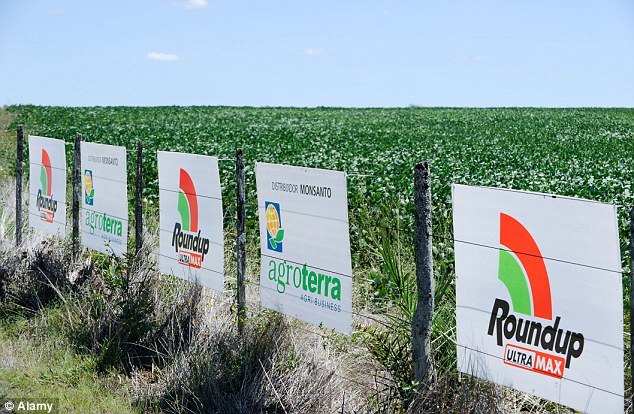

Carcinogenic Glyphosate is Found Everywhere, Exposure Through Food, Water, Air
GLY and AMPA (its major metabolite) are found in: air, surface water, groundwater, rainfall, soil, dust, plants, animals, people, etc. (Gillam 2011; Grossman 2015; Honeycutt, et al. 2015; IARC 2015; Pala 2015; Scribner, et al. 2003). Most people get exposed through contaminated food because our entire diet (excluding organics) is thoroughly contaminated with industrial agriculture’s pesticide residues (Samsel & Seneff 2013). In addition, in large-scale industrial farming: cows, pigs, sheep, goats, chickens and even farm-raised fish and shrimp are fed a diet primarily of GM grains and forage materials laced with herbicide (GLY is the primary herbicide used on GM crops). As a consequence, animal products, including meats, eggs, butter, cheese and milk, are contaminated with GLY and other pesticide residues that we then consume. Curiously, the legally “acceptable” level of glyphosate contamination in foods and feeds has been steadily increasing not due to scientific evidence, but based on the simple fact that the residue levels are increasing because so much GLY is being used (Bøhn & Cuhra.2014; Cherry 2010; Samsel & Seneff 2013; Seneff 2015).
Adding insult to injury, GLY-exposed and GM crops have been found to be nutritionally inferior to conventional crops and even more so to organic crops (Bøhn, et al. 2013; Bøhn & Cuhra 2014; Halweil 2006; Holderbaum, et al. 2015; Samsel & Seneff 2013). GM crops also take up much higher levels of GLY into their leaves; hence, they yield higher GLY concentrations in derived foods compared to non-GMO counterparts (Bøhn, et al. 2013; Samsel & Seneff 2013).
Intense and continuous use of glyphosate has resulted in the emergence of GLY-resistant weeds, or “superweeds” (Knezevic 2007; Shaner, et al. 2012) that are now found on nearly 100 million acres in 36 states (Landrigan & Benbrook 2015). Farmers respond by treating fields with higher doses and more applications and/or with multiple herbicides and/or with more toxic herbicides. And the number of resistant species keeps increasing, as does the overall cost of weed control. Consequently, this leads to higher levels of GLY residue in foods and feeds.
Eschewing the “pesticide treadmill” in favor of organic agricultural methods, with proper integrated pest management (IPM), offer the most viable alternative for low-toxic ecological sustainability and less pesticide contamination of the food chain (Anon 2015; Druker 2015; Goodall 2005; Halweil 2006; IPMP 2015; Lopez 2012; Pollan 2008; Seneff 2015). And, yes, organic methods of agriculture with a consciousness and responsibility towards the environment can feed the world without social, economic or other disadvantages.
You, your children, and your pets can be exposed to GLY when touching plants that have wet or freshly dried spray. Residue can be ingested on/in food, in contaminated water, or from contaminated hands or clothing, and via inhalation (Cox 2000; Gillam 2011) and dermal absorption (IARC 2015). Pets (e.g., dogs, cats) are likely exposed to residues from several sources (e.g., air, dust, plants, and soil), through several pathways and routes, after lawn applications. Pets can become a pathway for the transfer and translocation of pesticide residues inside the home where occupants are exposed through contact (Lu 2014).
In humans, only small amounts of GLY are metabolized to AMPA; the rest enters the bloodstream to be excreted in the urine, and/or eliminated in feces (Samsel & Seneff 2013; IARC 2015); and we now know that it bioaccumulates in lungs, lymph, blood, urine, bone and bone marrow (Gale & Null 2015), and breast milk too (Honeycutt et al. 2015). While Monsanto has consistently denied GLY bioaccumulation, their own studies found it in red cells, thyroid, uterus, colon, testes and ovaries, shoulder muscle, nasal mucosa, heart, lung, small intestine, abdominal muscle and the eyes. An insidious matter with GLY in mammals is that it manifests slowly over time as inflammation damages cellular systems throughout the body. Bringing this concern closer to home, is GLY used at your residence, in your neighborhood, or workplace? How exposed are you to GLY in your daily life?
STORY: Soil and Nutrition: No-Till Organics and Carbon Sequestration
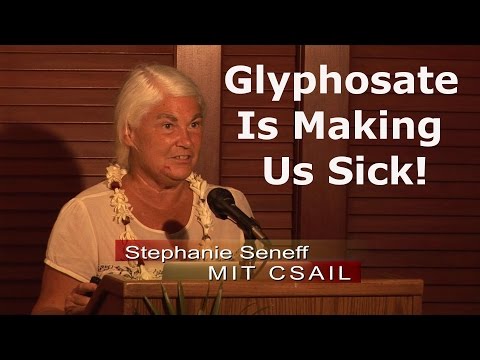
Watch this video on YouTube
Stephanie Seneff, PhD, MIT CSAIL presents “The ‘SAFE’ Herbicide that’s making us all Sick!” Seneff’s three decades of scientific rigor is added to a growing body of independent research that exposes the toxic reality of the U.S.’s favorite weed killer and biocide; Monsanto’s RoundUp.
Ever-present Carcinogenic Eco-Toxic Contaminant: Glyphosate
GLY is found in soil to which it adsorbs strongly (Xu, et al. 2011); however, its immobility therein depends on soil characteristics, bacterial content, soil thickness, moisture content, and sunlight intensity. GLY is broken down by soil microbes primarily to AMPA that can accumulate in the environment and is more mobile than glyphosate (IARC 2015). If GLY reaches surface water, it is not broken down readily by water or sunlight. In field studies, the half-life of GLY ranged between a few days to several months, or even more than a year as discovered in high glyphosate contamination levels in Scandinavian surface waters (Ludvigsen & Lode 2001).
GLY is a surface water contaminant due to both its aquatic usage, and through erosion as it adsorbs to soil particles suspended in runoff. The U.S. Geological Survey found GLY contamination in the majority of rivers, streams, ditches, and wastewater treatment plant outfalls tested in 38 states (Goldman, et al. 2015; Kolpin, et al. 2006; Scribner, et al. 2003). A Swiss study revealed that water contamination was not limited to agricultural runoff; in some areas, more than half of the contamination comes from urban drainage systems (Hanke, et al. 2010).
GLY and AMPA have become ubiquitous ecotoxic contaminants in freshwater ecosystems, including sediments, worldwide. They accumulate in bodies of water and sediments where they harm non-target microorganisms, invertebrates, amphibians and fish (Abdel-Mallek et al. 1994; Annett, et al. 2014; Quarles 2015a; Tanney & Hutchison 2010).
Substances occurring in surface waters deserve extra scrutiny because they enter a matrix that is the habitat of numerous aquatic organisms and the basis of our drinking water reserves (Székács and Darvas. 2011). Drinking water is an irreplaceable essential part of our diet, and is a potential vehicle for chronic exposure (the basis of chronic diseases) in daily contact and consumption.
Thus, both agricultural and non-agricultural applications of GLY are of significant concern, and both contribute to general pollution of the biosphere. Obviously, it is all interconnected and we are all exposed. Environmental architect William McDonough has wisely cautioned that, “We must not toxify the mass assets (the earth’s soil, air, water, and vegetation) that we all need to survive.” Complacency with this state of affairs is not recommended and should not be tolerated.
Effects = “Who’s Who Tour of a Medical Dictionary”
Glyphosate may be the most important factor in the development of multiple chronic diseases and conditions prevalent in Westernized societies (Barrett 2014; IARC 2015; Samsel & Seneff 2013; Seneff 2015; Székács and Darvas 2011; Thongprakaisang, et al. 2013; Vazquez 2014; Walia 2014a). These include: autism spectrum disorder (ASD); ADHD; gastrointestinal issues such as inflammatory bowel disease, chronic diarrhea, colitis and Crohn’s disease; obesity; cardiovascular disease; depression; sleep disorders; cancers, including non-Hodgkins lymphoma and breast; cachexia; Alzheimer’s disease; Parkinson’s disease; multiple sclerosis (MS); Lou Gehrig’s disease or amyotrophic lateral sclerosis (ALS); developmental malformations; infertility; antisocial & aggressive behaviors; among others.
As incredible as this list appears, the GLY-maligned biological/cellular processes can logically explain the features that are characteristic of the diseased states mentioned (IARC 2015); Samsel & Seneff, 2013). Key pathological effects (that accumulate over time) of GLY include:
- Kills/disrupts gut bacteria that depend on the shikamate pathway thus reducing the production of essential amino acids
- Disrupts the balance of microbiota in the gut allowing pathogens to dominate
- Impairs sulfate and phosphate transport
- Interferes with Cytochrome P450 enzyme activity (CYP enzymes have been identified in all domains of life; and play many important roles in the mammalian liver)
- Chelates important minerals (iron, cobalt, manganese, etc.)
- Interferes with synthesis of aromatic amino acids and methionine, leading to shortages in critical neurotransmitters and folate
It’s additionally unsettling that GLY, its additives, and AMPA induce oxidative stress that disrupts the body’s ability to detoxify other environmental toxins and leads to synergistic enhancement of toxicity (IARC 2015; Samsel & Seneff, 2013). Note that Monsanto found some of the same diseases and conditions given herein, but such data were misrepresented or hidden in order to promote corporate economic interests (Gale and Null. 2015; Seneff, 2014, 2015). Clearly, other environmental toxins, and genetics, also contribute to these diseases and conditions. However, GLY may be the most significant environmental toxin, mainly because it is used everywhere and often handled carelessly due to its perceived, industry-touted “benign” chemistry. Seneff (2014) has suggested that if the current trend of increasing GLY usage continues, by 2025 half the children born in the U.S. will be diagnosed with autism.
While Monsanto continued to deny the malign effects of GLY (and before the recent mega-procurement of Monsanto’s data), 17 experts from 11 countries met at WHO’s International Agency for Research on Cancer (IARC, Lyon, France) in March 2015 to assess the carcinogenicity of glyphosate and some other pesticides, including the herbicide 2,4-D. The IARC review committee found glyphosate in farmworkers’ blood and urine, chromosomal damage in cells, increased risks of non-Hodgkin lymphoma in people exposed, and tumor formation in animal studies. Both glyphosate and 2,4-D were ultimately classified as “probably carcinogenic to humans”, especially with chronic exposures (Guyton 2015). This is significant because at nearly the same time, the U.S. EPA approved the registration of Enlist Duo, a new herbicide from Dow AgroSciences that combines the two carcinogens, GLY and 2,4-D (US-EPA 2015). Basically, this product’s registration was an egregious irresponsible act by the U.S. EPA that ignores the plethora of well-known toxicity problems regarding GLY, and capitulates to the wishes of agribusiness (Salvador 2014; Seneff 2015).
STORY: Vandana Shiva: Maintaining Biodiversity and the Seeds of Freedom
Alliances with Government and Academic Institutions
Through deceit and institutionalized greed, data has been misrepresented, masked, or falsified to win regulatory and public approval in order to bring GLY to market, and all at a cost to human, animal, and environmental health. There is active collusion between the agribusiness and chemical industries, journal editorial boards, government agencies, numerous and often prominent academics, PR companies, and key administrators of land grant universities for the purpose of promoting GM crops and associated pesticides (BfR 2015; Druker 2015; Gale & Null 2015; Goldman, et al. 2015; Goodall 2005; IARC 2015; Lopez 2012; Pala 2015; Quarles 2015b; Salvador 2014; Seneff 2014; Séralini, et al. 2014; Székács and Darvas 2011; Testbiotech 2015; UCS 2014; Vallianatos 2014; Vazquez 2014; Walia 2014b).
“Get your facts first, then you can distort them as you please.” —Mark Twain
In the U.S., the alliances with industry (e.g., BASF; Monsanto; Pioneer; Syngenta; the American Chemistry Council; the Biotechnology Industry Organization; the Council for Biotechnology Information; the Grocery Manufacturer’s Association; and the Information Technology & Innovation Foundation) have included: the EPA; FDA; USAID; USDA/APHIS; Cornell University; Cornell Alliance for Science; Harvard University; Mississippi State University; Pennsylvania State University; Tuskegee University; University of California, Riverside; University of Florida; University of Illinois; and Yale Law School (Landrigan and Benbrook 2015; Latham 2015; Lipton 2015; Mesnage, et al. 2014; Simon 2012).
Where is the virtue in this scenario? We need to question regulatory agencies (e.g., EPA, FDA, USDA) that allow sequestering of data that have implications for public and environmental health (Druker 2015; Quarles, 2015b; Séralini, et al. 2014; Vallianatos 2014). The value and credibility of science is undermined without transparency of, and access to, all raw data obtained by companies and accepted by regulatory agencies as proof of safety for products. Having unsavory corrupt scientists and officials within an organization tends to further discredit said organization and leaves all of their work open to question. Considering the extensive degree of deception and the innumerable adverse health and environmental consequences regarding GLY, should not some of these players be charged with at least crimes of omission and/or challenged with toxic tort lawsuits?
STORY: GMO Agriculture: The Case Against Monsanto


Take Action
We live in a society that becomes upset when learning of an automobile manufacturer that hid evidence of faulty mechanicals resulting in the injury or death of numerous people; or of one that manipulated engine software to give false data regarding air pollution that had adverse effects on many people and the environment. Such concern is totally warranted. But, oddly, we seem almost inured to the consequences of all-pervasive pesticides such as GLY that have resulted in a far greater loss of life and quality of life on a global scale — whether it be human, animal, microbe, or the environment, all suffer.
Balancing industry-backed propaganda against vetted science on GLY-based products (and GLY-tolerant crops and GMOs) results in a sum total that equals “misery.” It is the appalling interconnected health- and environmental-related findings reviewed here that are causing governments and organizations around the world to limit GLY products or ban them altogether, including: Columbia; Costa Rica, El Salvador, England, France, Germany, Mexico, Netherlands, Russia, Sri Lanka, and Tasmania (Anon 2009; Appleby 2015; Barrett 2014; Cassidy 2015; CentralAmericaData.com. 2013; Druker 2015; IARC 2015; Jayasumana, et al. 2014; Lopez 2012). Similar actions should now be taken by the U.S. EPA, allowing the U.S. to follow the sound environmental policies of governments that are not overtly vested in agribusiness’s bottom line.
To be responsible to California’s populace, the CA-EPA:
- First, needs to enforce California’s Safe Drinking Water and Toxic Enforcement Act of 1986 – Prop. 65 (OEHHA, 2015) – see sidebar NOTICE. This would result in accurately labeling herbicide products on store shelves, but, unfortunately, would not give us a clue if GLY is in our food.
- Second, since GLY products are much more toxic than we originally thought is an unambiguous reason to require labeling of GM foods because they do contain GLY residues, and they end up on our tables to be unintentionally ingested by our most sensitive individuals: babies, children, pregnant women, and the elderly.
- Third, knowing that glyphosate is a probable carcinogen (and is used all around us everyday) should be more than enough reason for the CA-EPA and our “conscientious” legislators to initiate measures to ban the use of all glyphosate products in order to best protect human, animal, and environmental health. But don’t hold your breath…corporate interests have been known to take precedence over public and environmental health.
Meanwhile, do you know what’s used on your lawn, garden, school playgrounds, athletic fields, parks, golf courses, and along your roads? Ignorance can be misery, not bliss.
NOTICE: The California Environmental Protection Agency’s (CalEPA) Office of Environmental Health Hazard Assessment (OEHHA) has published a notice in the California Regulatory Notice Register (Register 2015, No. 36-Z) announcing its intent to list parathion, malathion and glyphosate as known to the State to cause cancer under the Safe Drinking Water and Toxic Enforcement Act of 1986. Obviously, all three should be listed as carcinogens; but Monsanto knows no shame and is contesting this effort to protect the public and environment.
Stephen C. Frantz
REFERENCES
Abdel-Mallek, A.Y., M.I. Abdel-Kader, and A.M. Shonkeir. 1994. Effect of glyphosate on fungal population, respiration and the decay of some organic matters in Egyptian soil. Microbiol Res.,149(1): 69-73.
Annett, R., H. R. Habibi, and A. Hontela. 2014. “Impact of glyphosate and glyphosate-based herbicides on the freshwater environment.” J Appl Toxicol 34: 458–479. (doi: 10.1002/jat.2997)
Anon. 2009. “Monsanto Uprooted: Germany bans cultivation of GM corn.” SpiegelOnline: 04/14/2009.
Anon. 2014. Glyphosate studies: A list of peer-reviewed studies that have found health and/or environmental harm from glyphosate. GMO Free USA. 92pp. (http://www.gmofreeusa.org/research/glyphosate/)
Anon. 2015. Scotland bans GM crops to protect the nation’s ‘clean, green’ brand. Herald Scotland: 8 August 2015.
Appleby, M. 2015. Glyphosate fears see Roundup pulled at West Six and North One. Horticulture Week: 10 July 2015.
Balbuena, M.S, L. Tison, M.-L. Hahn, U. Greggers, R. Menzel, and W. M. Farina. 2015. Effects of sub-lethal doses of glyphosate on honeybee navigation. J Exper Biology: July 10, 2015. (doi: 10..1242// dev..117291)
Barrett, M. 2014. Meta-analyses find link between glyphosate and cancer of the lymph tissue. Natural Society: May 1, 2014. (http://naturalsociety.com/meta-analyses-finds-association-glyphosate-cancer-lymph-tissue/)
BfR. 2015. BfR Communication No 008/2015 from 2 April 2015.
Bøhn, T., and M. Cuhra. 2014. How “Extreme Levels” of Roundup in food became the industry norm. Independent Science News: March 24, 2014.
Bøhn, T., M. Cuhra, T. Traavik, M. Sanden, J. Fagan, and R. Primicerio. 2013. Compositional differences in soybeans on the market: Glyphosate accumulates in Roundup Ready GM soybeans. Food Chemistry 153 (2014) 207–215.
CA-DPR. 2015. Summary of Pesticide Use Report Data 2013 Indexed by Chemical. CA Environmental Protection Agency, Dept. of Pesticide Regulation, Sacramento, CA. May 2015: 765pp. (www.cdpr.ca.gov)
Carman, J.A., H.R. Vlieger, L.J. Ver Steeg, V.E. Sneller, G.W. Robinson, C.A. Clinch-Jones, J.I. Haynes, J.W. Edwards. 2013. A long-term toxicology study on pigs fed a combined genetically modified (GM) soy and GM maize diet. J Organic Systems 8 (1): 38-54.
Cassidy, E. 2015. California moves to protect citizens from Monsanto’s GMO weed killer. EWG/AgMag BLOG September 10, 2015.
CentralAmericaData.com.2013. El Salvador: Use of 53 chemicals banned: Sept.6, 2013.
Cherry B. 2010. GM crops increase herbicide use in the United States. Science in Society 45, 44-46.
Cox, C. 2000. Glyphosate factsheet: Part 2 of 2. J Pesticide Reform: 108 (3); Fall ’98 rev. Oct ’00
Druker, S. M. 2015. Altered genes, twisted truth. Clear River Press, Salt Lake City, UT. 511pp
Franz, J.E., M.K. Mao, and J.A.Sikorski. 1997. Glyphosate: A unique global herbicide. ACS Monogr 189. Amer Chem Soc, Washington, D.C., USA.
Gale, R. and G. Null. 2015. Monsanto’s sealed documents reveal the truth behind Roundup’s toxicological dangers. Global Research, September 16, 2015 (http://www.globalresearch.ca/monsantos-sealed-documents-reveal-the-truth-behind-roundups-toxicological-dangers/5476443)
Gillam, C. 2011. U.S. researchers find Roundup chemical in water, air. Reuters/Green Business; August 31, 2011.
Goldman, G., C. Carlson and Y. Zhang. 2015. Bad chemistry: How the chemical industry’s trade association undermines the policies that protect us. Center for Science and Democracy. 30pp. (www.ucsusa.org/badchemistry)
Goodall, J. 2005. Harvest for hope: a guide to mindful eating. Warner Books, New York. 296pp.
Grossman, E. 2015. “What do we really know about Roundup weed killer?” National Geographic. (http://news.nationalgeographic.com/2015/04/150422-glyphosate-roundup-herbicide-weeds/)
Guha, N., M. H. Ward, R. Gunier, J.S. Colt, C.S. Lea, P. A. Buffler, and C. Metayer. 2013. Characteristics of residential pesticide use and chemical formulations through self-report and household inventory: The Northern California Childhood Leukemia Study. Environ Health Perspect. 121(2):276-82. (http://dx.doi.org/10.1289/ehp.1204926)
Guyton, K.Z., D. Loomis, Y. Grosse, F. El Ghissassi, L. Benbrahim-Tallaa, N. Guha, C. Scoccianti, H. Mattock, and K. Straif. 2015. Carcinogenicity of tetrachlorvinphos, parathion, malathion, diazinon, and glyphosate. Lancet: 16 (5): 490–491.
Halweil, B. 2006. “Can organic farming feed us all?” Worldwatch Magazine 19 (3)
Hanke, I., I. Wittmer, S. Bischofberger, C. Stamm, H. Singer. 2010. Relevance of urban glyphosate use for surface water quality. Chemosphere 81 (Issue 3): September 2010, 422-429.
Holderbaum, F., M. Cuhra, F. Wickson, A. Orth, R.O. Nodari, T. Bøhn. 2015. Chronic responses of Daphnia magna under dietary exposure to leaves of a transgenic (Event MON810) Bt-Maize hybrid and its conventional Near-Isoline. J Toxicol Environ Health 78(15):993-1007. (doi 10.1080/15287394.2015.1037877)
Honeycutt, Z., H. Rowlands, L. Grace. 2015. “Glyphosate Testing Full Report: Findings in American mothers’ breast milk, urine and water,” Moms Across America. April 7, 2015 (http://www.momsacrossamerica.com/glyphosate_testing_results)
IARC. 2015. Glyphosate. IARC Monographs—112: 92pp.
IPMP. 2015. Weed management. IPM Practitioner. 34 (11/12): 29-30.
Jayasumana, C., S. Gunatilake, and P. Senanayake. 2014. Glyphosate, Hard water and nephrotoxic metals: Are they the culprits behind the epidemic of chronic kidney disease of unknown etiology in Sri Lanka? Int. J Environ Res Public Health 2014, 11: 2125-2147 (http://www.mdpi.com/1660-4601/11/2/2125)
Knezevic, S. 2007. Glyphosate Resistance Prompts Integrated Management. Turfgrass Trends: February 2007. (www.turfgrasstrends.com)
Kolpin, D.W., E.M. Thurman, E.A. Lee, M.T. Meyer, E.T. Furlong and S.T. Glassmeyer. 2006. Urban contributions of glyphosate and its degradate AMPA to streams in the United States. Science of the Total Environment 354 (2-3):191-197. (http://toxics.usgs.gov/highlights/glyphosate_wastewater.html)
Kustin, M.E. 2015. “Glyphosate is spreading like a cancer across the U.S.” EWG-AgMag: April 7, 2015.
Landrigan, P.J. and C. Benbrook. 2015. GMOs, herbicides, and public health. N Engl J Med 2015; 373:693-695. (DOI: 10.1056/NEJMp1505660)
Latham, J. 2015. The Puppetmasters of academia (or what the NY Times left out). Independent Science News: Sept. 8, 2015.
Lipton, E. 2015. “Food industry enlisted academics in G.M.O. lobbying war, emails show.” New York Times: Sept. 5, 2015. (http://www.nytimes.com/2015/09/06/us/food-industry-enlisted-academics-in-gmo-lobbying-war-emails-show.html?_r=1)
Lopez, J. 2012. “Why Monsanto left Costa Rica.” Costa Rica Star News. February 12, 2012: 7pp.
Lu, C. 2014. A review of pesticide effects on sensitive receptors: children (draft). Dept. Envir. Health, Harvard Univ Sch of Public Health, Boston, MA.
Ludvigsen, G.H. and O. Lode. 2001. Results from the agricultural and environmental monitoring program of pesticides in Norway 1995 – 1999. Fresenius Environmental Bulletin 10: 470-474.
Mesnage, R., N. Defarge, J. Spiroux de Vendmois, and G-E. Seralini. 2014. “Major pesticides are more toxic to human cells than their declared active principles.” BioMed Research Internat 2014 (2014), Article ID:179691.
Morandin, L.A. and M.L. Winston. 2005. “Wild bee abundance and seed production in conventional, organic, and genetically modified canola.” Ecological Applications (Impact Factor: 4.09). 06/2005; 15(3):871-881. (DOI: 10.1890/03-5271)
Pala, C. 2015. “Pesticides in paradise: Hawaii’s spike in birth defects puts focus on GM crops.” The Guardian: Sunday 23 August 2015. (http://www.theguardian.com/us-news/2015/aug/23/hawaii-birth-defects-pesticides-gmo)
Pleasants, J.M. and K.S. Oberhauser. 2012. “Milkweed loss in agricultural fields because of herbicide use: effect on the monarch butterfly population.” Insect Conserv Diversity, March 2012: 10pp.
Pollan, M. 2013. “Some of my best friends are germs.” New York Times Magazine: May 15, 2013.
Quarles, W. 2014. “What are you eating? Labeling genetically engineered food (GMOs).” IPM Practitioner 34 (5/6): 1-9.
Quarles, W. 2015a. “Pesticides and amphibian decline.” IPM Practitioner 29 (1-4): 3-13.
Quarles, W. 2015b. “Glyphosate a probable human carcinogen.” IPM Practitioner 34 (9/10): 4-5.
Salvador, R. 2014. “Breaking News: USDA and EPA clear Enlist™ to ignore science and protect industry profits.” Union of Concerned Scientists. (http://blog.ucsusa.org/breaking-news-usda-and-epa-clearly-enlist-to-ignore-science-and-protect-industry-profits-690)
Samsel, A. and S. Seneff. 2013. “Glyphosate’s suppression of cytochrome P450 enzymes and amino acid biosynthesis by the gut microbiome: Pathways to modern diseases.” Entropy 2013 (15): 1416-1463. (doi:10.3390/e15041416)
Scribner, E.A., W.A. Battaglin, J.E.Dietze and E.M. Thurman. 2003. Reconnaissance data for glyphosate, other selected herbicides, their degradation products, and antibiotics in 51 streams in nine Midwestern States, 2002: U.S. Geological Survey Open-File Report 03-217: 101pp. (http://toxics.usgs.gov/highlights/glyphosate02.html)
Seneff, S. 2014. “Is Roundup the toxic chemical that’s making us all sick?” MIT CSAIL June 5, 2014. (www.youtube.com/watch?v=a52vAx9HaCI)
Seneff, S. 2015. “Roundup and GMO and the rise of modern disease.” MIT CSAIL. (http://people.csail.mit.edu/seneff/Oahu2015.pdf)
Séralini, G-E., R. Mesnage, N. Defarge and J. Spiroux de Vendômois. 2014. “Conflicts of interests, confidentiality and censorship in health risk assessment: the example of an herbicide and a GMO.” Environmental Sciences Europe 2014, 26:13 (doi:10.1186/s12302-014-0013-6)
Shaner, D. L., Lindenmeyer, R. B., & Ostlie, M. H. (2012). “What have the mechanisms of resistance to glyphosate taught us?” Pest Management Science 68: 3–9.
Simon, M. 2012. “Serving science or Monsanto: Timing of AAAS statement on GMO labeling is highly suspicious.” EatDrinkPolitics, October 29, 2012.
Sze?ka?cs, A. and B. Darvas (2012). “Forty years with Glyphosate,” pp. 248-285. In: M. N. Hasaneen (Ed.). Herbicides – Properties, Synthesis and Control of Weeds. (http://cdn.intechweb.org/pdfs/25624.pdf)
Tanney, J.B. and L.J. Hutchison. 2010. “The effects of glyphosate on the in vitro linear growth of selected microfungi from a boreal forest soil.” Can J Microbiol. 2010 Feb;56(2):138-44. doi: 10.1139/w09-122
Testbiotech. 2015. EU Commission Declares report on glyphosate risk assessment a secret…but Monsanto had access. (glyphosate_data_secret.pdf)
Thongprakaisang, S., A. Thiantanawat, N. Rangkadilok, T. Suriyo, J. Satayavivad. 2013. “Glyphosate induces human breast cancer cells growth via estrogen receptors.” 2013. Food Chem Toxicol. 2013 Sep 59:129-36. (doi: 10.1016/j.fct.2013.05.057)
Transparency Market Research. 2014. Glyphosate market for genetically modified and conventional crops – Global industry analysis, size, share, growth, trends and forecast 2013 – 2019. (www.transparencymarketresearch.com/glyphosate-market.html)
UCS. 2014. “Are partisanship and industry Influence compromising the mission of the House Committee on Science?” Center for Science and Democracy, Union of Concerned Scientists, Cambridge, MA. 5pp. (www.ucsusa.org/committeeanalysis)
US-EPA. 2015. Registration of Enlist Duo: April 2, 2015. (http://www2.epa.gov/ingredients-used-pesticide-products/registration-enlist-duo)
Vallianatos, E.G. 2014. Poison spring: The secret history of pollution and the EPA. Bloomsbury Press, New York.
Vazquez, M.A. 2014. Cancer death rates now doubled in Argentina’s GMO agribusiness areas. (http://www.gmeducation.org/environment/p217794-cancer-deaths-double-in-argentina-s-gmo-and-intensive-cropping-areas.html)
Walia, A. 2014a. What parents need to know about Monsanto: “By 2025 One In Two Children Will Be Autistic”. (http://www.collective-evolution.com/2014/12/20/what-parents-need-to-know-about-monsanto-by-2025-one-in-two-children-will-be-autistic/)
Walia, A. 2014b. “Scientists link autism to these toxic chemicals during fetal development.” (EduBirdie)
Xu, A., F. Ji, Z. Fan and L. He. 2011. “Degradation of Glyphosate in soil photocatalyzed by Fe3O4/SiO2/TiO2 under solar light.” Int J Environ Res Public Health 8 (1258-1270). (doi:10.3390/ijerph8041258)
Professionally, Stephen Frantz is a pathobiologist, concerned largely with animals that carry diseases to people, the conditions that enable such disease, and related environmental toxicology. He became an activist regarding civil rights and antiwar issues while a student at The Johns Hopkins University. He continues working in social and environmental justice, and serves on various local boards, including: the Americans for Democratic Action-SoCal; the Malibu Democratic Club; the Progressive Democrats of the Santa Monica Mountains; and the Topanga Creek Watershed Committee.
Updated 24 June 2022

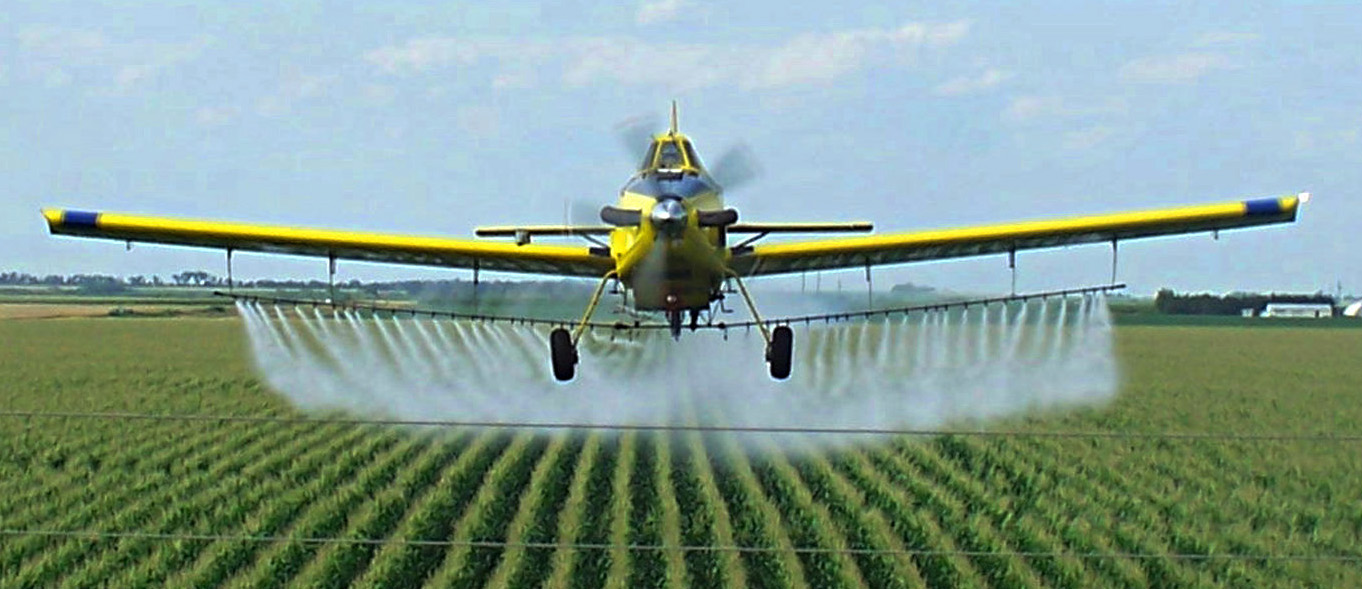



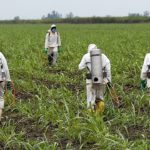







Pingback: Monsanto's RoundUp: Collusion, Corruption, and Lies Revealed | WilderUtopia.com
Pingback: Rewilding the Human Family: Staying Interconnected in Modern Times
Pingback: GMO Agriculture is Dangerous: The Case Against Bayer (Monsanto)
Pingback: Glyphosate Facts: What You Need To Know - WilderUtopia
It should not even be illegal. I remember when it came out and I was told by the rep at a hardware store that it kills everything from the inside out. I asked, won’t that affect our wildlife and our pollinators? What about us? The soil. He had no good answer and that was in the 80s or early 90’s….
How do we protect ourselves from this horrible stuff? It’s everywhere and should not be legal.